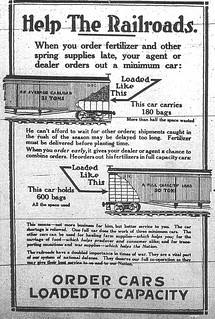
(Click on image to enlarge)
This public service announcement asking for cooperation in using railcars efficiently appeared in the Hobart News of January 3, 1918. It reflected serious problems the nation's railways were having with equipment shortages and traffic tie-ups.
Now we come to that episode of which I was ignorant before I got my hands on that 1918 timetable — the federal takeover of the railroads.
In its first issue of January 1918, the Gazette summed up the situation: "President Wilson, under his war powers, has assumed possession and control of all the railroads and steamship lines within the United States." Congress had given him such power under the Army Appropriation Act of 1916.
Over the previous 30 years or so, railroads had become increasingly important to the U.S. economy, and when the U.S. entered World War I they became vital to the movement of troops and supplies. But a decade of economic warfare between shippers and railroads had resulted in lagging capital improvements, neglected maintenance and depressed wages. By 1916 the railroads were already suffering from congestion at terminals and shortages of cars. The shortages were exacerbated by shippers' longstanding practice of using cars as rolling warehouses, allowing them to stand loaded and unmoving for days or weeks at a time.
President Wilson chose at first not to exercise his power with regard to the railroads. The heads of the railroad companies themselves formed the Railroads' War Board in an attempt to coordinate use of cars and rails to handle increasing traffic. But as the war went on, the volume of traffic rose beyond the capacity of this loose organization, and when the railroads tried to collaborate more closely, the U.S. Justice Department threatened to sue them for violation of the Sherman Anti-Trust Act. An early attempt by the federal government to implement traffic rationing failed due to competing bureaucracies and an ineffective administrator.
The autumn of 1917 saw a plentiful harvest, and its fruits needed to be shipped by rail; the early winter of 1917 proved severe, and everywhere people were ordering coal by rail. The result was rail gridlock, waste and shortages. On December 26, 1917, Wilson finally put control of the rails into the hands of the United States Railroad Administration.
He appointed as the USRA's director general William G. McAdoo, Secretary of the Treasury — and Wilson's own son-in-law, as McAdoo had married Eleanor Randolph Wilson at a ceremony in the White House in 1914.

William Gibbs McAdoo
Image credit: Wikimedia Commons.
McAdoo had been an attorney in private practice since 1892. In 1902 he became president of the Hudson and Manhattan Railroad Company, which built the first traffic tunnel under the Hudson River. During the presidential campaign of 1912, McAdoo was a vocal supporter of Wilson and chaired the Democratic National Committee. When Wilson became President, he appointed McAdoo Secretary of the Treasury. (According to one biographical sketch, McAdoo "is best remembered for having said, 'It is impossible to defeat an ignorant man in argument.'")
The USRA did not own the physical railroads — those remained the property of the railroad companies, and most of those companies continued to be run by the same management teams. But the railroads rented their tracks to the federal government, and in all matters of railroad traffic, the final say was McAdoo's.
In March of 1918 Congress passed the Federal Control Act, which gave the USRA sweeping powers: to override the Interstate Commerce Commission, state regulatory commissions, and shippers' orders; to set traffic priority for all other governmental departments as well as private shippers; to raise shipping rates and capital for needed improvements; to grant wage increases to railroad workers; and to do all of this with immunity from the antitrust laws.
Well, that would have made a nice essay for a high-school history class; only 35 years late. Tomorrow we'll get back to Ainsworth, or Hobart, at any rate, since Ainsworth news is still scarce, nobody having yet answered the call of the News for "a regular correspondent at Ainsworth."
Sources:
♦ Miller Center of Public Affairs, University of Virginia. "William G. McAdoo (1913–1918): Secretary of the Treasury." American President: An Online Reference Resource. http://millercenter.org/president/wilson/essays/cabinet/463 (accessed 11 Jan. 2011).
♦ Northrup, Cynthia Clark. The American Economy: A Historical Encyclopedia. Santa Barbara: ABC-CLIO, Inc., 2003.
♦ "President Takes Over RRs." Hobart Gazette 4 Jan. 1918.
♦ Venzon, Anne Cipriano (ed.) The United States in the First World War: An Encyclopedia. New York: Routledge, 1999.


No comments:
Post a Comment